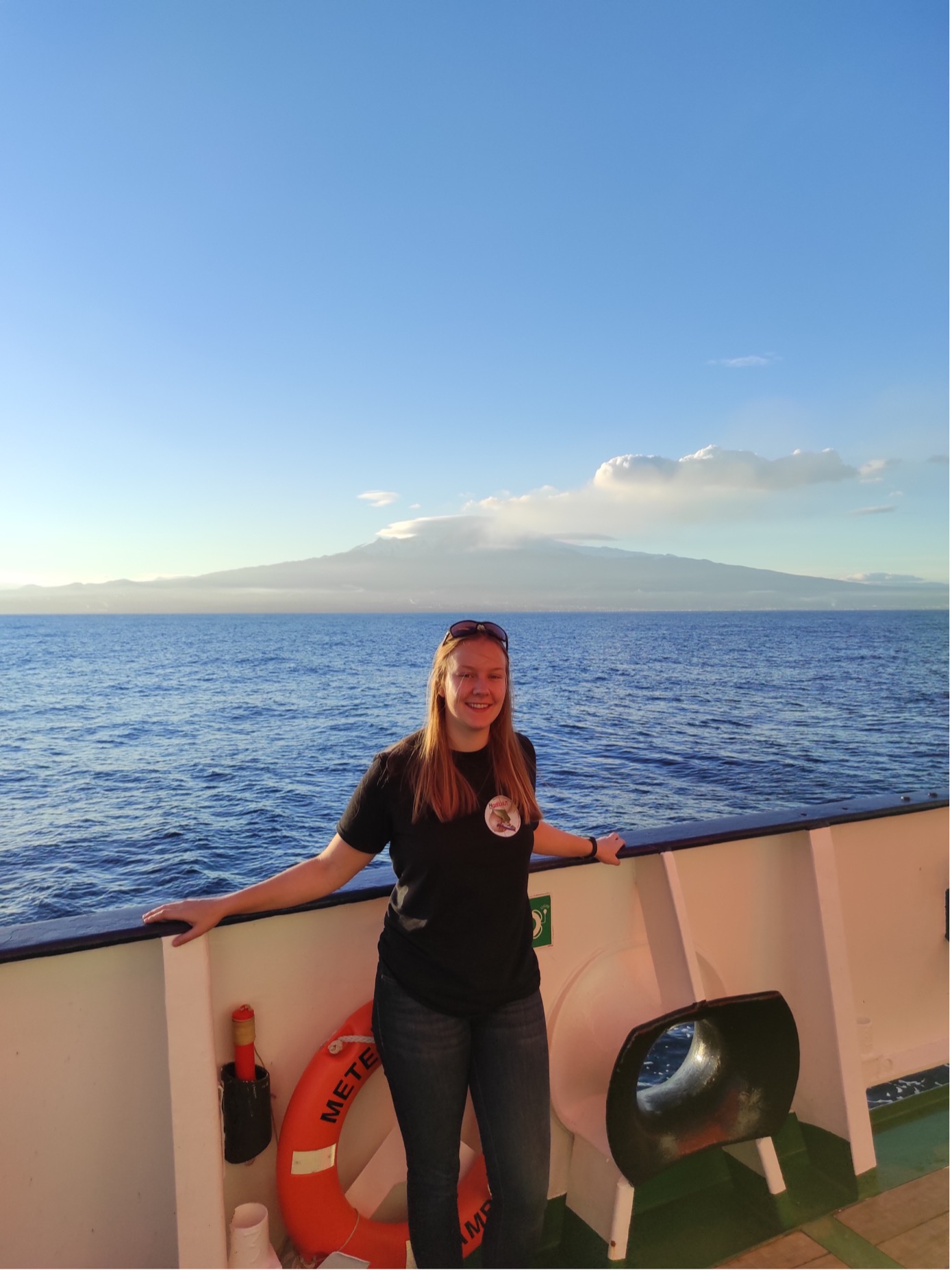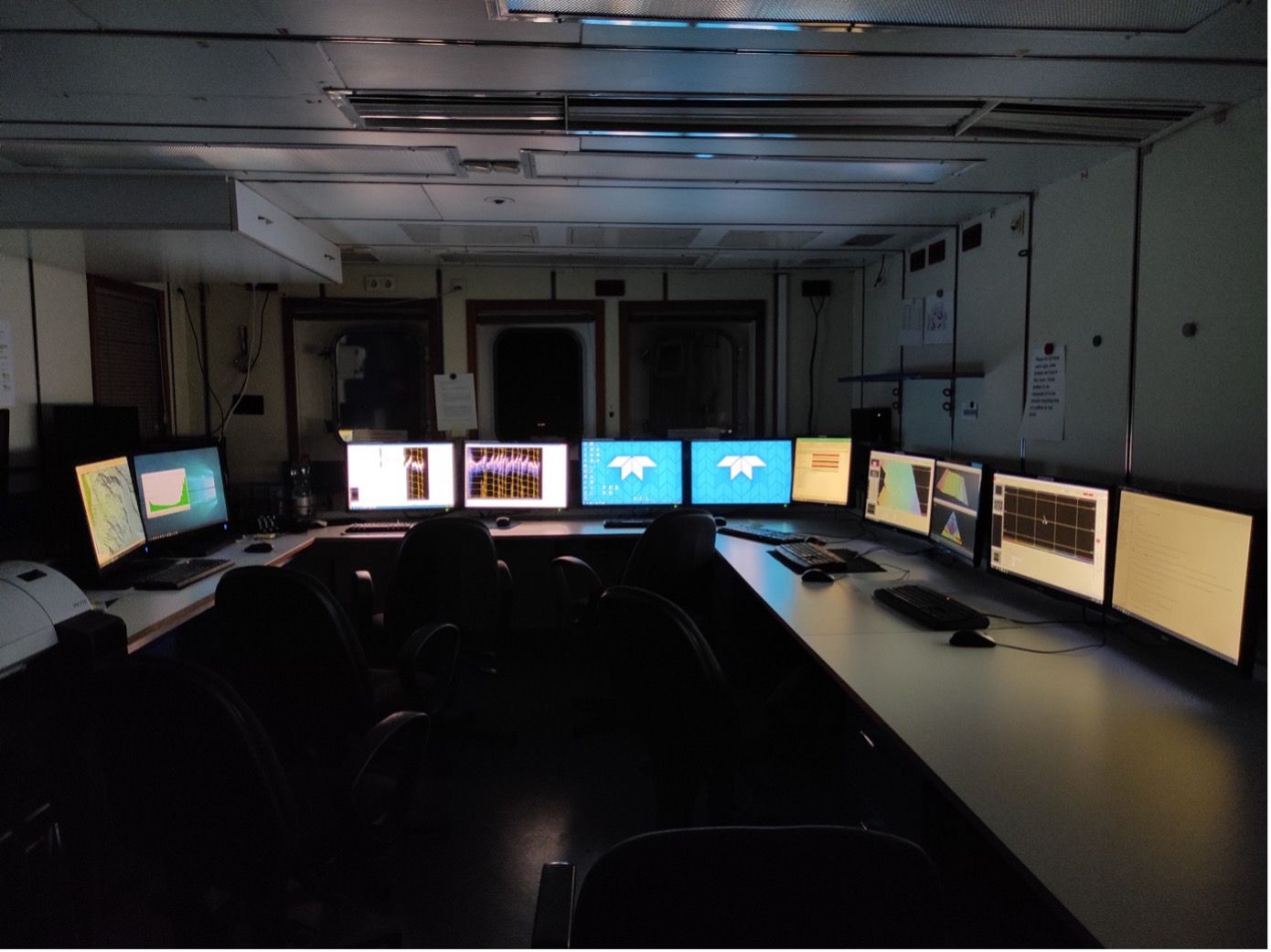Ich bin Emma, Masterstudentin an der Uni Bremen, Hiwi am Alfred-Wegener-Institut, und eine der wenigen „Ersties“ an Bord – M178 HazELNUT ist meine erste Fahrt auf einem Forschungsschiff. Meine Erfahrungen an Bord und meine spezielle Aufgabe im Team möchte ich euch ein bisschen näher beschreiben.
Natürlich wollte ich nicht unvorbereitet in die Ausfahrt starten und habe mich in meinem Umfeld umgehört, wie es an Bord so läuft und was ich unbedingt einpacken sollte. Erwartet hätte ich Antworten wie „Sonnencreme, Mütze, warmen Pullover“ – tatsächlich habe ich dann aber gleich fünfmal den Tipp bekommen ausreichend Socken einzupacken! Nicht etwa, weil die Socken ständig nass oder dreckig werden, sondern weil meistens Sockenknappheit der Grund ist, doch mal eine Maschine Wäsche zu waschen. Ein weiterer überraschender Tipp: Eine Hängematte. Die hat in der sizilianischen Sonne zur Mittagspause schon gute Dienste geleistet.
Inzwischen ist schon mehr als die Hälfte der Zeit auf See vergangen. Für meine nächste Ausfahrt werde ich neben noch mehr Socken und der Hängematte auf jeden Fall auch eine Musikbox und eine Sportmatte einpacken, für die Sonnenuntergang-Yoga-Sessions an Deck.
Auf dieser Ausfahrt bin ich Teil des Hydroakustik-Teams. Wir nutzen akustische Signale, die vom Schiff abgegeben werden und vom Meeresboden reflektiert werden. Ein Sensor fängt die reflektierten Signale wieder auf und misst, wie lange sie für den Weg zum Meeresboden und zurück zum Schiff gebraucht haben. Wenn man weiß, wie schnell sich die Schallsignale im Wasser bewegen, erhält man so Informationen über die Wassertiefe und kann eine genaue Karte des Meeresbodens erstellen. Wir nutzen dazu sowohl ein Multibeam Echolot als auch ein Sedimentecholot, das Parasound.
Weil wir tagsüber die hellen Stunden für Stationsarbeiten nutzen, in denen das Geologie-Team Kerne nimmt oder das Geodäsie-Team ihre Messstationen aussetzt, können wir tagsüber keine Messungen durchführen. Die hydroakustischen Messungen finden bei dieser Expedition meist nachts statt: Während die meisten FahrtteilnehmerInnen schlafen, arbeiten wir in einem vierstündigen Schichtsystem und fahren systematisch Profile ab und kartieren den Meeresboden vor dem Ätna.
Meine Wache beginnt um Mitternacht und dauert bis vier Uhr morgens. Das bedeutet, wenn alle anderen Schlafen gehen, mache ich mich auf den Weg ins Hydroakustik-Labor direkt unter der Brücke. Das hat den Vorteil, dass ich abends mit dem Team zusammensitzen, Kartenspiele spielen oder einen Film gucken kann. Es bedeutet aber auch, bis vier Uhr morgens wach zu sein – und am nächsten Morgen länger als die anderen zu schlafen. Das Frühstück fällt für mich aus, ich stehe gerade rechtzeitig zum Mittagsessen um 11:15 Uhr auf und höre mir während des Essens an, was ich vormittags alles verschlafen habe.
Während meiner Wache ist es wider Erwarten alles andere als einsam: Regelmäßig kommt die diensthabende Nautikerin/ der Nautiker von der Brück zu mir ins Labor und informiert mich über Kursänderungen. Auf meinem Weg nach Wachende in die Kammer begegnen mir auch mal wachhabende Besatzungsmitglieder. Auch schlaflose WissenschaftlerInnen sind schon das ein oder andere Mal im Hydroakustiklabor gestrandet…
Wenn ich endlich in meiner Kammer ins Bett falle, fängt eine Etage tiefer in der Kombüse Mike gerade an, die Brötchen für den nächsten Morgen zu backen. Nachts auf dem Forschungsschiff ist immer etwas los!


Night on the research vessel
My name is Emma, I am a master student at the University of Bremen, student assistant at Alfred-Wegener-Institute, and one of the few newbies on board – M178 HazELNUT is my first research cruise. I would like to share some of my experiences on board and explain my personal contribution to the cruise in the following.
Because I didn’t want to start this cruise without any preparation, I consulted friends and colleagues about life on board and what to bring with me. I was expecting recommendations such as “sunscreen, a wool hat, a warm sweater” – and was very surprised when as many as five people told me to bring lots of socks! Not because my socks would get wet or dirty all the time, but rather because a lack of socks will be the reason why one must do laundry after all. Yet another surprising recommendation: A hammock. A tip highly appreciated during sunny Sicilian lunchbreaks.
By now, more than half of my time on sea has passed. For my next cruise, I will not only pack even more socks and the hammock, but also a Bluetooth speaker and sports mat for the sunset-yoga-sessions on deck.
This cruise I am a part of the hydroacoustics team. We use acoustic signals emitted by the ship that are reflected by the seafloor. A sensor on board detects the reflected signals and measures the time the signals need to travel to the seafloor and back to the ship. Provided that one knows how fast the signal travels through the seawater, the information about the runtime can be used to calculate the depth of the seafloor and create a detailed map. To do so, we are using a multibeam echosounder as well as parasound.
During the day, Meteor is usually on station with the geology team taking cores or the geodesy team deploying their stations. Thus, we can’t do any hydroacoustic surveys simultaneously. Our measurements are done at night: While most of the scientists on board are sleeping, the hydroacoustics team is working four-hour-shifts, doing surveys and systematic profiles to map the seafloor offshore Etna.
My watch starts at midnight and lasts until 4 o’clock in the morning, meaning when everybody else goes to sleep I won’t go to my cabin but make my way upstairs to our lab, located right underneath the bridge. On the bright side I get to spend the evenings with the team playing cards or watching a movie, but at the same time I sleep late and skip breakfast – Usually I wake up just in time for lunch at 11:15 o’clock. While eating I enjoy my daily update of things I missed while sleeping in.
During my night watch, it’s not nearly as lonely as I expected in the beginning of the cruise. From time to time the navigator on duty comes down from the bridge to update me about course changes. And on the way back to my cabin after my watch it’s not uncommon to stumble into watchkeeping crew members. And rumor has it, that sleepless scientists come to visit in the hydroacoustics lab, have a little chat and steal some of our snacks…
And while I finally fall into bed in my cabin, our cook Mike begins to prepare breakfast for the next morning downstairs in the kitchen. There’s always something going on at night on a research vessel!
Text and Photos: Emma Hadre, Alfred-Wegener-Institut
Sounds like a great expierience indeed. Still vacant positions for next trip available? 😉